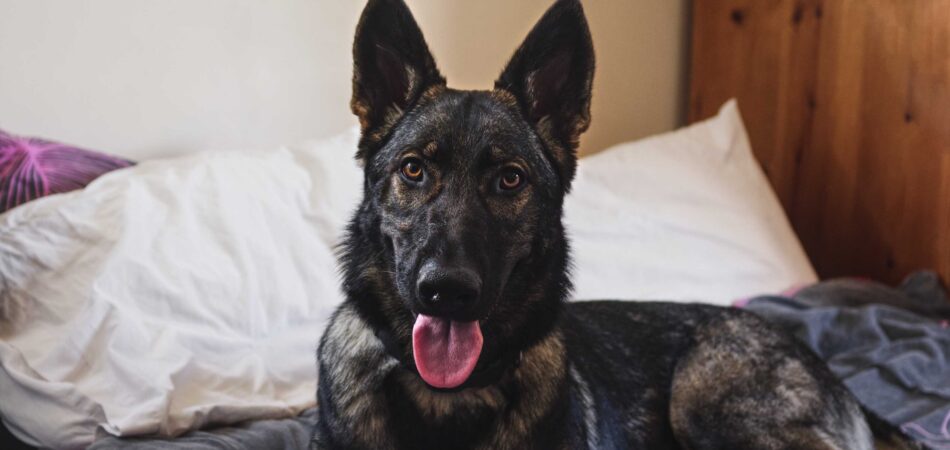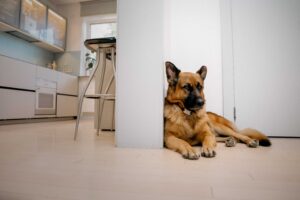






The internet has plenty to say about keeping protection dogs in apartments, and opinions are as divided as they come. For some, it’s a necessity—city life often means apartments are the only viable option for dog owners. For others, the idea conjures images of restless dogs, anxious neighbors, and a recipe for disaster.
I don’t believe it’s a black-and-white issue. Done the right way, living with a protection dog in an apartment can absolutely work. But it requires intention, effort, and a willingness to tackle the challenges that come with shared living spaces.
Now, this isn’t another generic “doggy etiquette in apartments” guide. You already know the basics: vaccinations, solid recall training, and the like. What you need are practical, actionable tips that go beyond the surface.
So, let’s get into it!
Is your building pet-friendly? This information might not always be front and center on the website, so grab your lease or reach out to your landlord or property manager for clarification. Some places don’t allow pets at all, while others have strict rules about the number, type, or size of dogs you can have.
For protection dog owners, this can get tricky. Many breeds commonly used for protection exceed standard weight limits. If you’re adopting a puppy, predicting its full-grown size might feel like a guessing game.
Plus, there are so many myths about aggression in protection dogs, so some landlords might push back even if your dog is well-trained and perfectly socialized.
It’s up to you to advocate for your dog by providing documentation of their training, proof of insurance, or even letters from trainers or veterinarians attesting to their behavior.
Now, here’s a key legal note: even if your building has a “no pets” policy, service animals and emotional support animals are often exceptions to the rule.
Under laws like the Fair Housing Act, service dogs—trained to perform specific tasks for their handlers—and emotional support dogs, which are prescribed by mental health professionals, are protected.
However, you still need to communicate with your landlord and provide proper documentation before moving in.

For starters, think functional decor. Use your dog’s leashes as a design element—hang them in the entryway as a charming focal point.
Got an adorable collection of dog bow ties? Display them in a hallway frame or shadow box. Even treats and poop bags can become part of the aesthetic when stored in chic, labeled jars. The goal isn’t to hide your dog’s presence—it’s to embrace it.
But functionality goes beyond decor. Safety is key. Educate yourself on which plants and foods are toxic for dogs (hint: chocolate, Xylitol, and dried fruits are big no-nos).
Keep harmful items well out of reach, and be mindful of things your dog might chew or swallow—plastic bags, hair ties, socks, and, yes, even underwear. A tidy apartment is a safer apartment.
Now, let’s talk about the space itself. Most protection dogs are big, energetic, and not exactly gentle around fragile decor. That delicate vase on the wobbly shelf? It’s practically begging to be knocked over. Opt for sturdy, pet-safe furniture and rearrange breakables to higher, more secure spots.
Finally, stock up on the essentials. High-quality dog food is a must, and durable toys are non-negotiable, especially for protection dogs. Add in grooming tools and anything else your dog needs for regular care.
Your dog’s personal space is their sanctuary. Whether it’s a crate, a designated corner with a comfy bed, or a specific room, your dog needs a place to decompress. This becomes especially important in the hustle and bustle of a shared living space.
Make it cozy, quiet, and off-limits to housemates or guests unless invited. This space should signal calm and security to your dog.
It’s where they go when they need a break—and where you send them when they need to reset.
For starters, noise sensitivity is a big deal. Your dog doesn’t need to bark every time someone walks by your door or the elevator dings. Teach them to differentiate between normal apartment sounds and actual threats. This is where commands like “quiet” and “settle” become your best friends.
Next, leash manners are non-negotiable. Hallways, stairwells, and elevators are tight quarters, often with unexpected encounters.
A well-trained dog that can heel calmly by your side, ignore distractions, and wait patiently for commands will save you from awkward or potentially dangerous situations.
Socialization is equally crucial. Your dog needs to get comfortable with the ebb and flow of apartment life—other dogs, kids running in the hall, or neighbors carrying groceries.
Gradual exposure paired with positive reinforcement can help your dog navigate these scenarios confidently and calmly.
Finally, consider working with a professional trainer who understands protection dogs and apartment dynamics. They can help tailor the training to fit your specific living situation, ensuring that your dog is not just well-behaved but also a good fit for communal living.
And if you’re wondering where to start, look no further than Vanguard Protection Dogs. Their expert training programs ensure your dog is prepared for life in any environment.
Your neighbors didn’t sign up to live with your dog, so you’ve got to manage expectations. That starts with open communication. Let them know you’re taking steps to keep your dog from being a disruption, and if it feels right, introduce your dog in a calm, friendly manner.
It’s also important to remember that not everyone loves dogs. Some people have allergies, others have fears—sometimes tied to specific breeds—and your job is to respect those boundaries while still managing your dog’s behavior.
Elevators are a particular hot spot for potential awkwardness—or worse, danger. Always keep the leash short, making it impossible for your dog to rush ahead of you.
And let’s make one thing crystal clear: no retractable leashes in or near elevators. A short leash ensures you and your dog enter together, reducing the risk of the nightmare scenario where your dog gets left outside as the doors close.
Pro tip: Teach your dog to stand between you and the wall in the elevator, leaving space for other passengers.
Then there’s noise—an apartment dweller’s eternal enemy. Barking at doorbells or passing strangers can quickly turn you into that neighbor.
As I said earlier, teach your dog to respond to a “quiet” command and redirect their energy with treats or toys. If your dog is naturally vocal, consider investing in a white noise machine or soundproofing your apartment to keep the peace.
And to be a good neighbor, be responsible for your dog’s waste. No one wants to smell or accidentally step in dog poop—it’s a surefire way to sour neighborly goodwill. Always pick up after your dog.
If you find the task unpleasant (and let’s be honest, who doesn’t?), look into tools or solutions that can make it more tolerable, like biodegradable poop bags with handles, pooper scoopers, or even scented disposal bags.
Let’s face it: an under-exercised protection dog in an apartment is a recipe for chaos. These breeds are wired with high energy levels and a need for both mental and physical stimulation. A quick lap around the block? That’s like handing a marathon runner a pair of flip-flops.
You’ve got to bring your A-game. Early morning jogs, long evening walks, or weekend hikes can help burn off energy.
Pressed for time? Opt for high-intensity activities like a spirited game of fetch in a secure area, tug-of-war, or agility drills.
Mental stimulation is just as important. Interactive toys, puzzle feeders, and scent games can work wonders in keeping your dog engaged. Obedience drills and new command training aren’t just practical—they’re brain workouts.
And don’t forget about consistent training sessions. Carve out time daily to reinforce commands and practice behaviors.
This not only hones your dog’s sharpness but also strengthens your bond and ensures they adapt to life in a shared space.
Protection dogs form incredibly strong bonds with their owners—it’s part of what makes them exceptional at their job.
However, this deep attachment can sometimes transform into separation anxiety, which becomes particularly challenging in an apartment setting. A dog’s stress behaviors echo through shared walls and spaces.
When separation anxiety strikes, it might manifest as:
These behaviors can strain neighbor relationships and potentially lead to complaints or costly repairs.
The best approach? Stop separation anxiety before it starts.
Train your dog to be comfortable being alone for short periods, gradually increasing the time. Puzzle toys, treat-dispensing devices, and calming music can help keep them occupied and relaxed while you’re out.
If your dog is already struggling with separation anxiety, don’t panic. Cases like these are highly treatable with the right guidance.
Work with a professional trainer or behaviorist to create a plan tailored to your dog’s needs as soon as possible.
Dogs thrive on routine, and protection dogs are no exception. A consistent schedule helps your dog feel secure and reduces stress, especially in the sometimes chaotic environment of apartment living.
Start with set times for meals, walks, playtime, and training sessions. This structure gives your dog something to look forward to and prevents restlessness (which can lead to bad habits like chewing, barking, or pacing).
Speaking of routines: potty training. If you’re considering bringing a protection dog into an apartment, be brutally honest with yourself about those middle-of-the-night potty breaks. That 2 a.m. trek to the designated relief area becomes significantly more challenging when you’re living on the 28th floor with an elevator that seems to stop at every single floor.
The key to successful potty training lies in consistency. Feed your dog and schedule bathroom breaks at the same times each day.
Your dog’s digestive system operates like clockwork—if meals and water are offered at random times, you can expect equally random bathroom needs.
This unpredictability becomes especially challenging when every potty break involves an elevator ride and a walk to the designated area.
Living in an apartment comes with its own set of risks, like fire alarms, building maintenance. Keep an emergency go-bag ready with your dog’s essentials: food, water, medical records, a leash, and a muzzle (just in case).
Practice evacuation drills to help your dog stay composed in high-stress situations. Familiarize them with the sound of fire alarms and any other building-specific alerts.
During drills, guide your dog confidently and calmly to the exit, reinforcing the idea that these actions lead to safety—not chaos. Positive reinforcement, like treats or praise, can solidify their trust in the process.
Lastly, ensure your dog always has an ID tag with up-to-date contact information. Microchipping is another excellent safety measure, offering added peace of mind that you’ll be reunited with your dog if you’re ever separated during an emergency.
Sometimes, the best thing you can do is call in the pros. A certified trainer or behaviorist can offer tailored advice and solutions for your specific situation.
The truth is, not every dog is naturally suited to apartment life. I’ve seen cases where dogs adopted from rescues—despite their owners’ best intentions—struggled to adjust.
They needed more space, a quieter environment, or simply the freedom of a yard where they could safely explore without the constant influx of unfamiliar people and pets. For these dogs, rehoming was the kindest option.
That’s why starting with the right training and preparation is so important. If you’re looking for the gold standard in protection dog training, Vanguard Protection Dogs is the answer.
Known for our world-class training and unmatched expertise, we specialize in developing protection dogs who are not only highly skilled but also adaptable in any environment, from urban to rural life.
Now….we’re not the cheapest. We’re not trying to be. We’re trying to be the best.
So, if you’re ready to experience the difference that world-class training makes – if you’re ready to bring a protection dog in your apartment —then let’s talk.